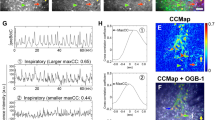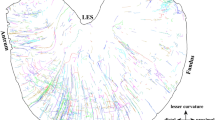Abstract
THE presence of large nerve cells in the abdominal ganglion of Aplysia has provided a valuable preparation for the study of the physiology of invertebrate neurones1–8. The largest cell is usually referred to as the giant nerve cell1–3,6–8 and it may be 300–800µ in diameter. It is excited synaptically by pathways entering most, if not all, of the nerves of this ganglion, but its only efferent axon passes anteriorly along the right pleuro-visceral connective. As almost all the work on the abdominal ganglion has been done with it completely isolated from the rest of the nervous system, the further path of this axon and the possible functions of this very large cell have not been understood. Experiments, which included the insertion of micro-electrodes into this giant cell when the abdominal ganglion retained its functional connexions with the rest of the nervous system in a whole animal preparation, have provided evidence for the branching of this axon and have excluded certain possibilities concerning the function of the giant cell.
This is a preview of subscription content, access via your institution
Access options
Subscribe to this journal
Receive 51 print issues and online access
$199.00 per year
only $3.90 per issue
Buy this article
- Purchase on Springer Link
- Instant access to full article PDF
Prices may be subject to local taxes which are calculated during checkout
Similar content being viewed by others
References
Arvanitaki, A., Arch. int. Physiol., 52, 381 (1942).
Arvanitaki, A., and Chalazonitis, N., C.R. Acad. Sci., Paris, 240, 349 (1955).
Arvanitaki, A., and Chalazonitis, N., Arch. Sci. Physiol., Paris, 10, 95 (1956).
Tauc, L., J. Physiol., Paris, 47, 769 (1955).
Tauc, L., Arch. Ital. Biol., 96, 78 (1958).
Tauc, L., C.R. Acad. Sci., Paris, 250, 1560 (1960).
Tauc, L., J. Physiol. (London), 152, 36 (1960).
Tchou-Si-Ho, Contribution à l'étude de la physiologie des cellules nerveuses chez l'Aplysie (Bosc et Rion, Lyon, 1942).
Eales, N. B., L.M.B.C. Mem. 24 Aplysia (1921).
Author information
Authors and Affiliations
Rights and permissions
About this article
Cite this article
HUGHES, G., TAUC, L. The Path of the Giant Cell Axons in Aplysia depilans . Nature 191, 404–405 (1961). https://doi.org/10.1038/191404a0
Issue Date:
DOI: https://doi.org/10.1038/191404a0
This article is cited by
-
Si-Ho Tchou: life of a legend from physiology to psychology
Protein & Cell (2019)
-
Functional and morphological evidence for the existence of neurites from abdominal ganglion bag cell neurons in the head-ring ganglia of Aplysia
Journal of Comparative Physiology A (1991)
-
Morphological properties of neuron RPD1 in lymnaea stagnalis and its involvement in processing of polymodal sensory information
Neurophysiology (1988)
-
Blocking action of intracellularly injected neuraminidase on central synapses in vivo
Pfl�gers Archiv European Journal of Physiology (1980)
-
Anatomy of giant serotonin-containing neurones in the cerebral ganglia of Helix pomatia and Limax maximus
Zeitschrift f�r Zellforschung und mikroskopische Anatomie (1973)
Comments
By submitting a comment you agree to abide by our Terms and Community Guidelines. If you find something abusive or that does not comply with our terms or guidelines please flag it as inappropriate.



